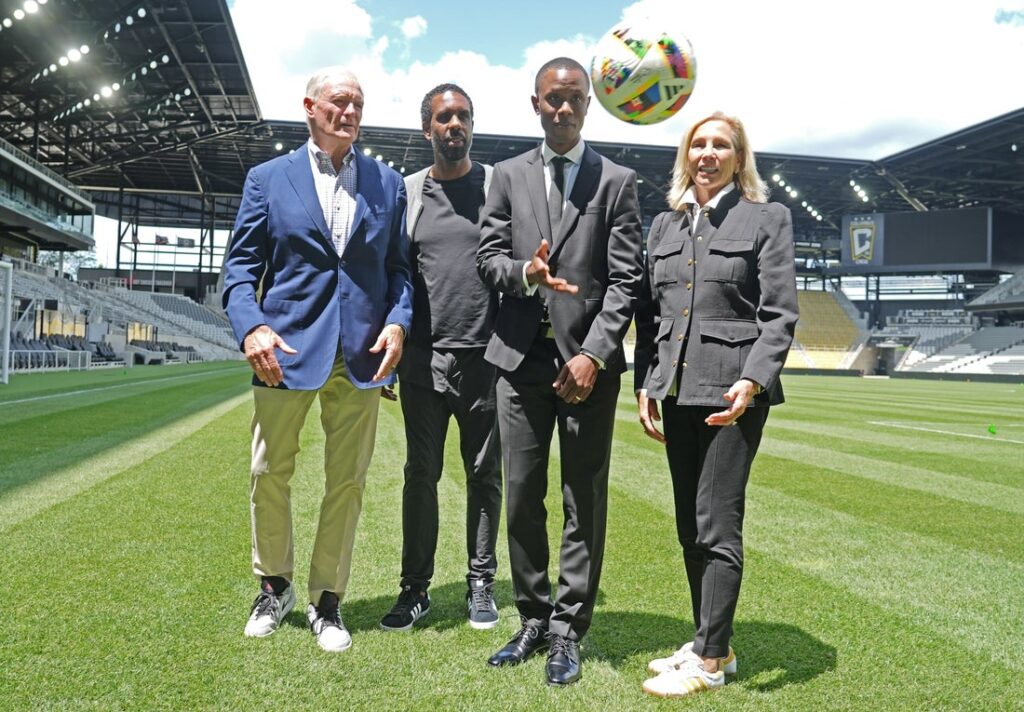- Sports 150
- Posts
- Tennis An Asset Class? Wimbledon Makes The £383.7M Case
Tennis An Asset Class? Wimbledon Makes The £383.7M Case
Broadcast rights now drive 56 % of Wimbledon’s record £383.7 M haul, while shared-finals coverage, $125 M in sponsorship, and a £53.5 M prize pool show how the All England Club keeps turning heritage into high-margin growth.
Good morning, ! This week we’re diving into Wimbledon media rights, Cristiano Ronaldo’s new media intensive contract, Alex Rodriguez becoming a business mogul through real estate and strategic partnerships, and the $1.5B Minnesota Timberwolves acquisition.
Join 50+ advertisers who reach our 400,000 executives: Start Here.
Know someone who would love this? Forward it their way! Here’s the link.
— The Sports150 Team
DATA DIVE
Wimbledon’s $500M Serve

Wimbledon doesn’t just serve aces—it prints money. The 2023 tournament generated a record £383.7M ($500M) in revenue, with over 56% of that coming from broadcast rights alone. Notably, 2025 will mark the first time in 88 years that the BBC shares finals coverage, signaling a shift in how heritage brands approach media monetization. Add in $124.7M in sponsorship, a record-breaking £53.5M prize pool, and over 532,000 attendees, and you’ve got a prestige product that doubles as a financial fortress. Even its strawberries and cream are strategic—$60M in merch and concessions is a sweet side hustle.
MEDIA & SPORTS
Ronaldo’s Contract Is a Broadcast Strategy in Disguise

Cristiano Ronaldo’s £492M deal with Al-Nassr is less about scoring goals and more about owning eyeballs. The perks? A 15% equity stake, private jet, and full-time staff. But the real flex? He’s effectively become Al-Nassr’s media division. Since signing, the club’s Instagram blew past 28M followers, and the Saudi Pro League landed new international broadcast deals in Europe, Asia, and Latin America. With 600M+ followers, Ronaldo isn’t just a player—he’s a content platform, a global channel, and an accelerator for Vision 2030. The message: if you want global reach, don’t buy a network—sign one. (More)
The Private Markets Intelligence Summit of the Year
📍 October 15, 2025 | Well& by Durst, NYC
Join 300+ private markets leaders—GPs, LPs, operating partners, and advisors—for a single day of insights, strategy, and dealmaking at the New York Private Capital Summit.
This isn’t another networking event. It’s where strategy meets substance:
→ Keynotes from HarbourVest’s CEO, Bloomberg, Australian Super
→ Deep-dives on secondaries, direct lending, GenAI, and ESG
→ Practical panels on fund formation, human capital, and tax strategy
→ A spotlight on emerging liquidity tools and NAV-based financing
With over 50 senior speakers from firms like Apollo, KKR, Carlyle, Neuberger Berman, and Warburg Pincus, the Summit is designed for decision-makers driving the next decade of private capital.
Reserve your seat before it sells out: Early Bird Access
INVESTOR CORNER
Timberwolves’ $1.5B Exit: A Case Study in NBA Valuation Dynamics
The NBA has officially approved the $1.5B sale of the Minnesota Timberwolves and WNBA’s Lynx to Marc Lore and Alex Rodriguez, closing a saga four years in the making. It’s a legacy-defining exit for Glen Taylor, who paid $88M in 1994 and exits amid soaring NBA franchise values—with Forbes and Sportico now estimating the Wolves’ worth at $3.1B–$3.29B.
The valuation math reveals a more complicated picture. Lore and A-Rod’s price reflects a 2021 agreement, signed when NBA multiples lagged today’s highs. Since then, media rights and investor appetite have surged—yet Minnesota remains in a midsized market with a 35-year-old arena, keeping it in the bottom third by league value.
More intriguing: the WNBA’s Lynx were included, with Sportico pegging them at $240M—suggesting growing momentum in women’s sports M&A. Also in the buyer group: Michael Bloomberg and Eric Schmidt, signaling that sports franchises are now core alternative assets for the ultra-wealthy.
Bottom line: This deal underscores the growing bifurcation in NBA valuations. Even a “cheap” $1.5B team now includes a WNBA franchise, billionaire backing, and still carries upside—just in time for a new media rights cycle. (More)
ENTREPRENEURS
Alex Rodriguez: From Slugger to Sports Mogul
Alex Rodriguez didn’t just retire into commentary—he rewrote the athlete-to-investor playbook. After earning $450M+ in MLB salaries, A-Rod parlayed his brand and capital into a diversified portfolio spanning real estate, media, fitness, and tech.
His holding company, A-Rod Corp, manages investments across more than 30 companies, including stakes in Acorns, Hims & Hers, and UFC Gym. But Rodriguez’s most visible play is in team ownership. After a failed bid for the Mets, he co-led the $1.5B acquisition of the NBA’s Timberwolves and WNBA’s Lynx, now finalized.
His investor group—featuring Marc Lore, Michael Bloomberg, and Eric Schmidt—signals the shift: athlete-led deals are evolving into institutional-grade capital platforms. Rodriguez brings not just capital, but media savvy and governance acumen, now serving as governor of the Lynx and alternate governor for the Wolves.
Why it matters: Rodriguez is part of a new class of ex-athletes leveraging fame into full-stack ownership. The goal isn’t just influence—it’s infrastructure. And in an era of rising franchise values, it’s a position that pays generational dividends. (More)
COLLEGE ATHLETICS
College Athletics Just Got an OS Upgrade
College sports are now a tech lab. Wearable sensors like Under Armour’s “genius” shirts track everything from heart rate to hydration, helping coaches personalize training and spot red flags before injuries happen. Meanwhile, VR systems let athletes run plays without running at all—boosting skill development and tactical IQ while cutting injury risk. Then there’s the data layer: platforms that dissect everything from football blitz packages to baseball swing angles. Add in AI-driven recruitment tools and real-time fan stat feeds, and it’s clear the modern college athlete isn’t just trained—they’re optimized. (More)
TOGETHER WITH 1440 MEDIA
Seeking impartial news? Meet 1440.
Every day, 3.5 million readers turn to 1440 for their factual news. We sift through 100+ sources to bring you a complete summary of politics, global events, business, and culture, all in a brief 5-minute email. Enjoy an impartial news experience.
TECH & INFRASTRUCTURE
Pickleball’s $855M Infrastructure Crunch
Pickleball may be light on gear, but it's heavy on infrastructure needs. In 2024, U.S. participation jumped 45.8% year-over-year, topping 19.8M players, and marking the fourth consecutive year as America’s fastest-growing sport. Courts, however, are struggling to keep up.
There are now nearly 69,000 pickleball courts in public parks. Yet the Sports & Fitness Industry Association estimates that the U.S. will require $855M in court construction over the next five to seven years to match demand. Cities like Calvert, KY are already doubling their court count less than two years after initial builds.
The sport's demographic has also flipped: the average age is now 34.8, and 25–34-year-olds represent the largest age group (2.3M players). Even kids are joining—1M children picked up a paddle last year. That’s translating into a gold rush for equipment makers too, with 476 new manufacturers approved by the SFIA in 2024 alone.
Bottom line: For investors eyeing recreation infrastructure, pickleball is no longer a niche—it’s a scalable real estate play. (More)
eSPORTS
The Million-Dollar Jersey Patch That Got Smarter

Esports marketing has grown from billboard branding to full-blown community infiltration. In 2017, total ad and sponsorship revenue was $339M—by 2024, it’s pushing $1B. That’s not just growth; it’s validation. The old playbook of slapping logos on jerseys is out. Today’s brands are co-producing content, backing causes, and even embedding with fanbases like cultural anthropologists. It's part marketing, part lifestyle branding, and all high-conviction spend. As esports expands beyond its niche, marketers aren’t chasing impressions—they’re chasing immersion. (More)
INTERESTING ARTICLES
TWEET OF THE WEEK
A new Parity report shows 51% of women’s sports fans follow the WNBA, with WTA, NWSL, and LPGA at 19–20% 📈
Emerging leagues like PVF (15%) and LOVB (10%) are gaining traction.
MORE — ow.ly/pXqs50WghW3
— Sports Business Journal (@SBJ)
9:00 PM • Jun 29, 2025
"The biggest risk is not taking any risk. In a world that's changing quickly, the only strategy that is guaranteed to fail is not taking risks."
Mark Zuckerberg





